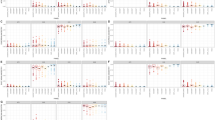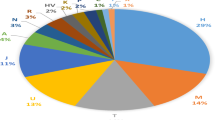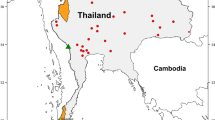Abstract
Multiple questions relating to contributions of cultural and demographical factors in the process of human geographical dispersal remain largely unanswered. India, a land of early human settlement and the resulting diversity is a good place to look for some of the answers. In this study, we explored the genetic structure of India using a diverse panel of 78 males genotyped using the GenoChip. Their genome-wide single-nucleotide polymorphism (SNP) diversity was examined in the context of various covariates that influence Indian gene pool. Admixture analysis of genome-wide SNP data showed high proportion of the Southwest Asian component in all of the Indian samples. Hierarchical clustering based on admixture proportions revealed seven distinct clusters correlating to geographical and linguistic affiliations. Convex hull overlay of Y-chromosomal haplogroups on the genome-wide SNP principal component analysis brought out distinct non-overlapping polygons of F*-M89, H*-M69, L1-M27, O2a-M95 and O3a3c1-M117, suggesting a male-mediated migration and expansion of the Indian gene pool. Lack of similar correlation with mitochondrial DNA clades indicated a shared genetic ancestry of females. We suggest that ancient male-mediated migratory events and settlement in various regional niches led to the present day scenario and peopling of India.
Similar content being viewed by others
Log in or create a free account to read this content
Gain free access to this article, as well as selected content from this journal and more on nature.com
or
References
Cavalli-Sforza, L. L., Menozzi, P. & Piazza, A. The History and Geography of Human Genes, (Princeton University Press, Princeton, NJ, USA, 1994).
Wells, R. S., Yuldasheva, N., Ruzibakiev, R., Underhill, P. A., Evseeva, I., Blue-Smith, J. et al. The Eurasian heartland: a continental perspective on Y-chromosome diversity. Proc. Natl Acad. Sci. USA 98, 10244–10249 (2001).
Armitage, S. J., Jasim, S. A., Marks, A. E., Parker, A. G., Usik, V. I. & Uerpmann, H. P. The southern route "out of Africa": evidence for an early expansion of modern humans into Arabia. Science 331, 453–456 (2011).
Majumder, P. P. Ethnic populations of India as seen from an evolutionary perspective. J Biosci. 26, 533–545 (2001).
Majumder, P. P. The human genetic history of South Asia. Curr. Biol. 20, R184–R187 (2010).
Sengupta, S., Zhivotovsky, L. A., King, R., Mehdi, S. Q., Edmonds, C. A., Chow, C. E. et al. Polarity and temporality of high-resolution y-chromosome distributions in India identify both indigenous and exogenous expansions and reveal minor genetic influence of Central Asian pastoralists. Am. J. Hum. Genet. 78, 202–221 (2006).
Sun, C., Kong, Q.-P., Palanichamy, M. G., Agrawal, S., Bandelt, H.-J., Yao, Y.-G. et al. The dazzling array of basal branches in the mtDNA macrohaplogroup M from India as inferred from complete genomes. Mol. Biol. Evol. 23, 683–690 (2006).
ArunKumar, G., Soria-Hernanz, D. F., Kavitha, V. J., Arun, V. S., Syama, A., Ashokan, K. S. et al. Population differentiation of Southern Indian male lineages correlates with agricultural expansions predating the caste system. PLoS ONE 7, e50269 (2012).
Trivedi, R., Sahoo, S., Singh, A., Bindu, G. H., Banerjee, J., Tandon, M. et al. Genetic imprints of Pleistocene origin of Indian populations: a comprehensive phylogeographic sketch of Indian Y-chromosomes. Int. J. Hum. Genet. 8, 97–118 (2008).
Sharma, S., Rai, E., Sharma, P., Jena, M., Singh, S., Darvishi, K. et al. The Indian origin of paternal haplogroup R1a1(*) substantiates the autochthonous origin of Brahmins and the caste system. J. Hum. Genet. 54, 47–55 (2009).
Underhill, P. A., Myres, N. M., Rootsi, S., Metspalu, M., Zhivotovsky, L. A., King, R. J. et al. Separating the post-Glacial coancestry of European and Asian Y chromosomes within haplogroup R1a. Eur. J. Hum. Genet. 18, 479–484 (2010).
Sahoo, S., Singh, A., Himabindu, G., Banerjee, J., Sitalaximi, T., Gaikwad, S. et al. A prehistory of Indian Y chromosomes: evaluating demic diffusion scenarios. Proc. Natl Acad. Sci. USA 103, 843–848 (2006).
McAlpin, D. W. Proto-Elamo-Dravidian: the evidence and its implications. Trans. Am. Phil. Soc. 71, 3–155 (1981).
Kumar, V., Reddy, A. N., Babu, J. P., Rao, T. N., Langstieh, B. T., Thangaraj, K. et al. Y-chromosome evidence suggests a common paternal heritage of Austro-Asiatic populations. BMC Evol. Biol. 7, 47 (2007).
Chaubey, G., Metspalu, M., Choi, Y., Magi, R., Romero, I. G., Soares, P. et al. Population genetic structure in Indian Austroasiatic speakers: the role of landscape barriers and sex-specific admixture. Mol. Biol. Evol. 28, 1013–1024 (2011).
Basu, A., Mukherjee, N., Roy, S., Sengupta, S., Banerjee, S., Chakraborty, M. et al. Ethnic India: a genomic view, with special reference to peopling and structure. Genome Res. 13, 2277–2290 (2003).
Cordaux, R., Saha, N., Bentley, G. R., Aunger, R., Sirajuddin, S. M. & Stoneking, M. Mitochondrial DNA analysis reveals diverse histories of tribal populations from India. Eur. J. Hum. Genet. 11, 253–264 (2003).
Kivisild, T., Rootsi, S., Metspalu, M., Mastana, S., Kaldma, K., Parik, J. et al. The genetic heritage of the earliest settlers persists both in Indian tribal and caste populations. Am. J. Hum. Genet. 72, 313–332 (2003).
Palanichamy, M. G., Sun, C., Agrawal, S., Bandelt, H. J., Kong, Q. P., Khan, F. et al. Phylogeny of mitochondrial DNA macrohaplogroup N in India, based on complete sequencing: implications for the peopling of South Asia. Am. J. Hum. Genet. 75, 966–978 (2004).
Chaubey, G., Karmin, M., Metspalu, E., Metspalu, M., Selvi-Rani, D., Singh, V. K. et al. Phylogeography of mtDNA haplogroup R7 in the Indian peninsula. BMC Evol. Biol. 8, 227 (2008).
Reich, D., Thangaraj, K., Patterson, N., Price, A. L. & Singh, L. Reconstructing Indian population history. Nature 461, 489–494 (2009).
Moorjani, P., Thangaraj, K., Patterson, N., Lipson, M., Loh, P. R., Govindaraj, P. et al. Genetic evidence for recent population mixture in India. Am. J. Hum. Genet. 93, 422–438 (2013).
Juyal, G., Mondal, M., Luisi, P., Laayouni, H., Sood, A., Midha, V. et al. Population and genomic lessons from genetic analysis of two Indian populations. Hum. Genet. 133, 1273–1287 (2014).
Elhaik, E., Greenspan, E., Staats, S., Krahn, T., Tyler-Smith, C., Xue, Y. et al. The GenoChip: a new tool for genetic anthropology. Genome Biol. Evol. 5, 1021–1031 (2013).
Elhaik, E., Tatarinova, T., Chebotarev, D., Piras, I. S., Maria Calo, C., De Montis, A. et al. Geographic population structure analysis of worldwide human populations infers their biogeographical origins. Nat. Commun. 5, 3513 (2014).
Miller, S. A., Dykes, D. D. & Polesky, H. F. A simple salting out procedure for extracting DNA from human nucleated cells. Nucleic Acids Res. 16, 1215 (1988).
Haak, W., Balanovsky, O., Sanchez, J. J., Koshel, S., Zaporozhchenko, V., Adler, C. J. et al. Ancient DNA from European early neolithic farmers reveals their near eastern affinities. PLoS Biol. 8, e1000536 (2010).
Yang, W. Y., Novembre, J., Eskin, E. & Halperin, E. A model-based approach for analysis of spatial structure in genetic data. Nat. Genet. 44, 725–731 (2012).
Kozlov, K., Chebotarov, D., Hassan, M., Triska, M., Triska, P., Flegontov, P. et al. Differential evolution approach to detect recent admixture. BMC Genomics. VarI-Sig 2014 Special Issue (2015).
Jombart, T. adegenet: a R package for the multivariate analysis of genetic markers. Bioinformatics 24, 1403–1405 (2008).
Pickrell, J. K. & Pritchard, J. K. Inference of population splits and mixtures from genome-wide allele frequency data. PLoS Genet. 8, e1002967 (2012).
Weir, B. S. & Cockerham, C. C. Estimating F-statistics for the analysis of population structure. Evolution 38, 1358–1370 (1984).
Danecek, P., Auton, A., Abecasis, G., Albers, C. A., Banks, E., DePristo, M. A. et al. The variant call format and VCFtools. Bioinformatics 27, 2156–2158 (2011).
Cavalli-Sforza, L. L. Human evolution and its relevance for genetic epidemiology. Annu. Rev. Genomics Hum. Genet. 8, 1–15 (2007).
Shi, W., Ayub, Q., Vermeulen, M., Shao, R. G., Zuniga, S., van der Gaag, K. et al. A worldwide survey of human male demographic history based on Y-SNP and Y-STR data from the HGDP-CEPH populations. Mol. Biol. Evol. 27, 385–393 (2010).
Novembre, J. & Ramachandran, S. Perspectives on human population structure at the cusp of the sequencing era. Annu. Rev. Genomics Hum. Genet. 12, 245–274 (2011).
Alexander, D. H. & Lange, K. Enhancements to the ADMIXTURE algorithm for individual ancestry estimation. BMC Bioinformatics 12, 246 (2011).
Champaklakshmi, R. in Structure and Society in Early South India: Essays in Honour of Noboru Karashima (ed. Hall, K. R.) 59–84 (Oxford University Press, Delhi, India, 2001).
Mastana, S. S. & Papiha, S. S. Genetic variability of transferrin subtypes in the populations of India. Hum. Biol. 70, 729–744 (1998).
Metspalu, M., Kivisild, T., Metspalu, E., Parik, J., Hudjashov, G., Kaldma, K. et al. Most of the extant mtDNA boundaries in south and southwest Asia were likely shaped during the initial settlement of Eurasia by anatomically modern humans. BMC Genet. 5, 26 (2004).
Gayden, T., Cadenas, A. M., Regueiro, M., Singh, N. B., Zhivotovsky, L. A., Underhill, P. A. et al. The Himalayas as a directional barrier to gene flow. Am. J. Hum. Genet. 80, 884–894 (2007).
Reddy, B. M., Langstieh, B. T., Kumar, V., Nagaraja, T., Reddy, A. N., Meka, A. et al. Austro-Asiatic tribes of Northeast India provide hitherto missing genetic link between South and Southeast Asia. PLoS ONE 2, e1141 (2007).
Shastri, K. A. N. A History of South India: from Prehistoric Times to the Fall of Vijayanagar 4th edn (Oxford University Press, Madras, India, 1976).
Cai, X., Qin, Z., Wen, B., Xu, S., Wang, Y., Lu, Y. et al. Human migration through bottlenecks from Southeast Asia into East Asia during Last Glacial Maximum revealed by Y chromosomes. PLoS ONE 6, e24282 (2011).
Karafet, T. M., Mendez, F. L., Meilerman, M. B., Underhill, P. A., Zegura, S. L., Hammer, M. F. et al. New binary polymorphisms reshape and increase resolution of the human Y chromosomal haplogroup tree. Genome Res. 18, 830–838 (2008).
Acknowledgements
We gratefully acknowledge the volunteers from India and also thank the community leaders and fieldwork assistants who helped in sampling expeditions and sample identification. The Genographic Project was supported and funded by National Geographic Society, IBM and The Ted Wait Family Foundation, USA. TVT was supported by NIH, GM068968, and NIH-NICHD, HD070996.
Disclaimer
The funding agencies (National Geographic Society, IBM and The Ted Wait Family Foundation) had no role in design of the study, collection and analysis of data, and decision to publish.
Author information
Authors and Affiliations
Consortia
Corresponding author
Ethics declarations
Competing interests
The authors declare no conflict of interest.
Additional information
The participants of the Genographic Consortium are as follows: Christina J Adlera1, Elena Balanovska2, Oleg Balanovsky2, Jaume Bertranpetit3, Andrew C Clarke4, David Comas3, Alan Cooper1, Clio SI Der Sarkissian1, Matthew C Dulik5, Jill B Gaieski5, Wolfgang Haak1, Marc Haber3,6, Angela Hobbs7, Asif Javed8, Li Jin9, Matthew E Kaplan10, Shilin Li9, Begoña Martínez-Cruz3, Elizabeth A Matisoo-Smith4, Marta Melé3, Nirav C Merchant10, R John Mitchell11, Amanda C Owings5, Laxmi Parida8, Daniel E Platt8, Lluis Quintana-Murci12, Colin Renfrew13, Daniela R Lacerda14, Ajay K Royyuru8, Theodore G Schurr5, Fabrício R Santos14, Himla Soodyall7, David F Soria Hernanz15, Pandikumar Swamikrishnan16, Chris Tyler-Smith17, Pedro Paulo Vieira18, Miguel G Vilar5, R Spencer Wells15, Pierre A Zalloua6, and Janet S Ziegle19 1University of Adelaide, South Australia, Australia; 2Research Centre for Medical Genetics, Russian Academy of Medical Sciences, Moscow, Russia; 3Universitat Pompeu Fabra, Barcelona, Spain; 4University of Otago, Dunedin, New Zealand; 5University of Pennsylvania, Philadelphia, Pennsylvania, United States; 6Lebanese American University, Chouran, Beirut, Lebanon; 7National Health Laboratory Service, Johannesburg, South Africa; 8IBM, Yorktown Heights, NY, USA; 9Fudan University, Shanghai, China; 10University of Arizona, Tucson, AZ, USA; 11La Trobe University, Melbourne, Victoria, Australia; 12Institut Pasteur, Paris, France; 13University of Cambridge, Cambridge, United Kingdom; 14Universidade Federal de Minas Gerais, Belo Horizonte, Minas Gerais, Brazil; 15National Geographic Society, Washington, DC, USA; 16IBM, Somers, NY, USA; 17The Wellcome Trust Sanger Institute, Hinxton, United Kingdom; 18Universidade Federal do Rio de Janeiro, Rio de Janeiro, Brazil; and 19Applied Biosystems, Foster City, CA, USA.
Supplementary Information accompanies the paper on Journal of Human Genetics website
Supplementary information
Rights and permissions
About this article
Cite this article
ArunKumar, G., Tatarinova, T., Duty, J. et al. Genome-wide signatures of male-mediated migration shaping the Indian gene pool. J Hum Genet 60, 493–499 (2015). https://doi.org/10.1038/jhg.2015.51
Received:
Revised:
Accepted:
Published:
Issue date:
DOI: https://doi.org/10.1038/jhg.2015.51
This article is cited by
-
Contrasting maternal and paternal genetic histories among five ethnic groups from Khyber Pakhtunkhwa, Pakistan
Scientific Reports (2022)
-
Mitochondrial DNA diversity in the Khattak and Kheshgi of the Peshawar Valley, Pakistan
Genetica (2020)
-
WhoGEM: an admixture-based prediction machine accurately predicts quantitative functional traits in plants
Genome Biology (2019)
-
On Historic migration to South Asia in the last two millennia: A case of Jews and Parsi populations By Ajai Kumar Pathak, et al.
Journal of Biosciences (2019)
-
Ancient Human Migrations to and through Jammu Kashmir- India were not of Males Exclusively
Scientific Reports (2018)



